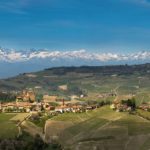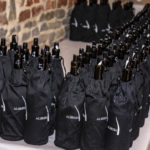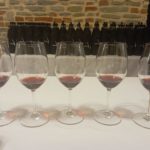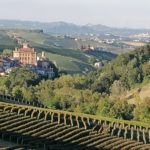
Each year the prominent arrival of Nebbiolo Prima has grown in importance and now represents the first opportunity to assess the new vintages of the champions of Piedmont: Barolo, Barbaresco and Roero. The Albesia consortium (Unione Produttori Vini Albesi) has been organizing this event for 26 years now. Founded to promote the great wines of the Alba region to the world, Albesia has given its name to the uniquely shaped and marked bottle that dates back to the 18th century Piedmontese master glassmakers. The Unione Produttori Vini Albesi remains today the entity that regulates and promotes usage of the bottle. Albeisa represents 301 members who produced 21 million bottles in 2020.
This year for Nebbiolo Prima they have organized an exclusive tasting with four days of intensive work dedicated to a central figure of the Italian wine scene and centered around the noblest of Italian native grape varietes, Nebbiolo, and its expression in the Barolo, Barbaresco and Roero territories. The name Nebbiolo comes from the Italian word “nebbia” which means fog or mist. A demanding yet sensitive grape that can truly express its originality and complexity when grown on the right south-facing slope in a rich, calcareous tufa-based soil such as those found in Barolo, Barbaresco and Roero.
This year tasters had the chance to review 311 wines produced by the 180 wineries represented at the event. At the tasting, all denominations and sub-zones were presented blind: DOCG Barolo 2019 and Riserva 2017, DOCG Barbaresco 2020 and Riserva 2018, and DOCG Roero 2020 and Riserva 2019, all the wines were a revealing testimony to the multitude of features that make up our incredible terroir.
Tasting report of Nebbiolo Prima 2023

Roero
Roero is that section of land located to the north of Alba town, in the province of Cuneo, on the left bank of the river Tanaro, between the plain of Carmagnola and the low hills of Asti. Compared to neighboring wine-growing areas it has a remarkable variety of landscapes with woods and orchards bordering the vineyards. Another unique characteristic of the Roero landscape is the Rocche, steep slopes dividing the territory from southwest to northeast, from Pocapaglia to Montà, separating the continental gravel and fluvial clay based soils from those of marine origin, where the vine finds its ideal conditions.
|
wine denomination DOCG (controlled and guaranteed designation of origin) |
grape | minimum ageing | released
on the market |
| Roero Docg | 95% Nebbiolo
5% other non-aromatic red grape |
20 months, of which 6 in wood | from the 1st July of second year after the harvest |
| Roero Docg Reserve | 95% Nebbiolo
5% other non-aromatic red grape |
32 months, of which in 6 wood |
from the 1st July of third year after the harvest |
Here below, the choices of Riccardo Margheri, a wine writer and wine expert, who replaced me at the event this year.
Tastings of Roero DOCG
Frea Lorenzo e Giovanni,
Roero DOCG Muschiavin 2020
A captivating nose of cherries and strawberries with a hint of pepper and aromatic herbs. The mouth is smooth with judicious tannins, yet enough freshness and salinity to make it savoury. The aftertaste is pleasant and straightforward with ripe fruit. Not a lot of depth but a bottle that is easily finished.
Cascina Lanzarotti di Ferrero Carlo Vittorio
Roero DOCG Bin Fait 2020
The intense nose is marked by bright, ripe red fruit that evokes an odea of sweetness, accompanied by tobacco and spices (but the hints of oak are very well integrated). The mouth is mellow, well calibrated in texture and tannin. This wine is not ambitious, but the expansion of the fruit is agreeable. Very well crafted. The intense nose is marked by a idea of sweetness, with bright, ripe red fruit, tobacco and spices (but the oak hints are very well integrated). The mouth is mellow, well calibrated in the amount and the texture of the not enormous tannin: the wine is not ambitious, but the expansion of the fruitiness is agreeable. Very well crafted.
Bric Castelvej
Roero Docg Riserva Panera Alta 2019.
An austere vintage that expresses straightforward maturity pursued with coherence. It can be already perceived when the glass is still far from the nose, and even the colour is deeper than average for Nebbiolo. Thus, it is not surprising for the sip being smooth and mouth filling, with a graceful sweetness that is not tiring, thanks to the savouriness that sustains the finish. It is not full and complex, but elegant.
Cascina Chicco
Roero Docg Riserva 2019 Valmaggiore
This assertive Riserva doesn’t lack fruit but is not some way stopped in its expansion by its same fullness. Hints of chocolate and blueberry on the nose; the palate is tasty, but with moderate acidity and the wine somehow stops its progression, due to a lot of “matter”, so far without nuance. Only in the aftertaste it shows hint of balsamic, something meaty and some more chocolate. Perhaps this reflects its youth and with time it will develop much more complexity.

Barbaresco
One of the first Italian Doc wines in 1966 and, in 1980, one of the first Docg wines. The area of production includes the entire territory of the villages of Barbaresco, Treiso and Neive, plus part of the territory of the Alba municipality.
|
wine denomination DOCG (controlled and guaranteed designation of origin) |
grape |
minimum ageing |
released on the market |
| Barbaresco Docg | 100% Nebbiolo | 26 months, of which 9 in wood | from the 1st January of third year after the harvest |
| Barbaresco Docg Reserve | 100% Nebbiolo | 50 months, of which 9 in wood |
from the 1st January of fifth year after the harvest |
Tastings of Barbaresco DOCG
Castello di Verduno
Barbaresco Docg 2020
Bright with a deep garnet core. Pronounced flavours of blackcherry with scents of roses. Spicy notes of liquorice. Good balance of body, fruit, acidity and velvety tannins. Long, vibrant, finish. Great wine.
Cascina Morassino, Marassino
Barbaresco Docg 2020
Medium garnet core, paler towards the edge. The wine displays intense floral notes mixed with balsamic scents and overtones of graphite. The palate expresses ripe fruit with a hint of vanilla. Good acidity, firm tannins and long finish. I really like it.
Giuseppe Cortese Rabajà
Barbaresco Docg 2020
Bright, deep garnet colour. The nose is rich in blueberry and forest floor aromas. Nice, vibrant entry in the palate. Medium body and harmonious structure with dried prune and licorice. Quite a long aftertaste.
Tenute Cisa Asinari dei Marchesi di Gresy,
Barbaresco Docg 2018 Riserva Camp Gros Martinenga
A very rainy vintage pushed producers to look more for elegance than fullness. So there’s floral fragrance on the nose, with traces of tobacco and citrus. The sip is mellow, but doesn’t lack savouriness and acidity, making it wonderfully balanced. It is still young, but aromatically the wine enters wide in the mouth, and it already starts to lengthen, waiting for a promising future.
Roberto Sarotto
Barbaresco Docg 2018 Riserva Currà.
The nose is a bit closed, indicating time is needed before the wine will show its best qualities. A long oxygenation reveals stylish fragrances of red fruit (mountain berries, etc.). The sip is juicy, big and powerful in its tannic structure, but also a pronounced saltiness carries the aromas long into the mouth, true to its vintage. The slightly present oak does not dry out the texture, leaving such a big wine remarkably easy to drink.

Barolo
The Grand Italian wine by definition, Barolo is made in eleven ‘communes’ or village territories: Barolo itself, La Morra, Monforte, Serralunga d’Alba, Castiglione Falletto, Novello, Grinzane Cavour, Verduno, Diano d’Alba, Cherasco, Roddi. Unlike Barolo, these communes are only permitted to cultivate Nebbiolo for Barolo on a part of their territor
|
wine denomination DOCG (controlled and guaranteed designation of origin) |
grape |
minimum ageing |
released on the market |
| Barolo Docg | 100% Nebbiolo | 38 months, of which 18 in wood | from the 1st January of fourth year after the harvest |
| Barolo Docg Reserve | 100% Nebbiolo | 62 months, of which 18 in wood |
from the 1st January of sixth year after the harvest |
Tastings of Barolo DOCG
Comm. G.B. Burlotto
Barolo Docg 2019
Medium garnet core with narrow tawny rim. Great nose with ripe plum, balsamic notes with hints of licorice and rhubarb. Slight notes of leather. Medium body with ripe red fruit and freshness. Moderate coarse tannins. Elegant, long finish.
Mauro Molino
Barolo Docg 2019
Clear, deep red garnet colour. Intense flavour of dark cherry and prune. Light notes of eucalyptus and rhubarb. The mouth is dense with medium soft tannins and hints of toast. Elegant wine with long and juicy aftertaste. This is an excellent wine.
Giacomo Fenocchio, Castellero
Barolo Docg 2019
Medium garnet red turning slightly tawny. Pronounced bouquet of black cherry, dried prune and leather. Overtones of coconut and the scent of incense. Lovely palate, deep fruit with firm tannins. Great potential.
Vajra, Bricco delle Viole
Barolo Docg 2019
Brilliant, deep garnet colour with compact rim. Varied and intense aromas of ripe plum, blackberry and tobacco. Rich in structure, with persistent ripe fruit well balanced with the firm tannins. Fresh long finish.
Barolo Docg 2019, Brezza Sarmassa
Bright with intense garnet core and paler rim. The wine displays red fruit and citrus notes mixed with earthy overtones. Exuberant and full body in the palate, elegant fruit and exuberant tannins. Long, fresh finish. Very good wine.
Tenuta Arnulfo
Barolo Docg 2017 Riserva, Costa di Bussia, Bussia
Garnet red with a paler tinge. It displays intense flavour of dark cherry with light earthy overtones. Juicy and vibrant with a medium-bodied palate, firm tannins with light smoky hint at the end. I really appreciated this wine.
Germano Ettore
Barolo Docg 2017 Riserva, Lazzarito
Intense ruby red colour with paler reflections. Intense flavour of black cherry and liquorice with overtones of lavender and new leather. Fragrant entrance with discrete alcohol and ripe fruit. Sweet, velvety tannins and quite long aftertaste. Harmonious, good wine.

I really wish to thank you to Liz Palmer, who kindly proposed me to participate and report on the Nebbiolo Prima 2023, representing her web site and blog together with Riccardo Margheri.
See you in Piedmont!